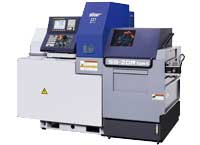Swiss Type Automatic Lathe SB-16R/20R type G Newly Released
SB Series Equipped with Guide Bush/Non-Guide Bush Switching Function
Features of SB-16R/20R type G
- Either the guide bush type or the non-guide bush type can be selected according to the total length of parts to machined.
- There are four options available for power tools to be mounted on the gang-type tool post: a 4-spindle-type cross drill unit, 5-spindle-type cross drill unit, 5-spindle-type cartridge cross drill unit and 5-spindle high-speed-type cartridge cross drill unit.
- When the 5-spindle-type or 5-spindle high-speed-type cartridge cross drill unit is mounted, a variety of tool units can be combined at three cartridge positions.
- The 4-spindle-type unit especially designed for back working is able to readily accommodate a tool rotation drive unit. This enhances functions of complex machining, including eccentric hole drilling, slotting, etc. on the rear end.
- The main spindle incorporates a built-in motor to achieve improved indexing accuracy.
- Both the main spindle and sub spindle are equipped with the C-axis control function as standard equipment.
Major Specifications
| SB-16R type G | SB-20R type G | |||
|---|---|---|---|---|
| Max. machining diameter | ø 16mm | ø 20mm | ||
| Max. headstock stroke | 205mm | |||
| Max.main spindle speed | 10000min-1 | |||
| Main spindle motor | 2.2kw / 3.7kw | |||
| Max. sub spindle speed | 9000min-1 | |||
| Sub spindle motor | 0.55kw / 1.1kw | |||
| Max. power-driven att. spindle speed | ER11 | 10000min-1 | ||
| ER16 | 6000min-1 | |||
| Power-driven att. drive motor | 1.0kw / 1.2kw | |||
| Max. drilling capability on the front-end | Stationary tool | ø 12mm | ||
| Power-driven tool | ER11 | ø 6mm | ||
| ER16 | ø 7mm | |||
| Max. tapping capability on the front-end | Stationary tool | M10 × P1.5 | ||
| Power-driven tool | ER11 | M5 × P0.8 | ||
| ER16 | M6 × P1.0 | |||
| Max. drilling capability on the rear-end | ø 8mm | |||
| Max. tapping capability on the rear-end | M6 × P1.0 | |||
| Dimensions(W × D × H) | 2070 × 1177 × 1760mm | |||
| Weight | About 1700kg | |||
NOTE 1: Swiss-type automatic lathe
The Swiss-type automatic lathe was devised as watch component processing machinery in Switzerland in 1870s. Known as a “sliding head-type automatic lathe” as well, it has remarkable characteristics of high-precision cutting of components with longer length compared with the diameter.
In general, if long and narrow parts are processed with a general-purpose lathe, flexure will occur on the workpiece, making finishing with the correct dimensions impossible. The Swiss-type automatic lathe utilizes a guide bush to function as a material steady rest. The tool, positioned at a certain distance from the guide bush, gives a cutting motion only the direction of outside diameter. This allows the workpiece to be cut accurately with no flexure. As for axial motion, the headstock, rather than the tailstock, moves while clamping a workpiece.
NOTE 2: Non-Guide Bush Type
This is a sliding head-type automatic lathe which is designed based on the Swiss-type automatic lathe with a guide bush dismounted. Without a guide bush, it is not best suited for machining narrow and long parts. If the workpiece is short and does not deflect without using a guide bush, however, such a material can be handled effectively.
With the Swiss-type automatic lathe, the rear side of the bar material needs to be handled as waste as a portion equivalent to the size of the guide bush structure which functions as a material steady rest cannot be machined. The non-guide bush type reduces the wastes from materials to about 1/3 in length compared to the waste made by the guide bush type.
NOTE 3: Slanted slide guideway structure
The machine main body base and the tool post are slanted and each sliding surface is in a trapezoidal shape, called a dovetail structure. This structure allows each sliding surface to come into contact with its entire plane to improve the machine rigidity. The ball screw center and the cutting point are close to each other to reduce a load (moment load) applied in the direction of torsion caused by cutting resistance.

